I’m almost certain there’s not a pilot alive who hasn’t at least heard of the Pilatus Porter. It has been around since 1959 and has been slowly and brilliantly evolving ever since then. It has remained pretty much unchanged since then but I bet many people would be surprised at the number of features the current model PC-6 B2-H4 has. Here’s 10 things you probably didn’t know the Porter has.
1) Glass cockpit
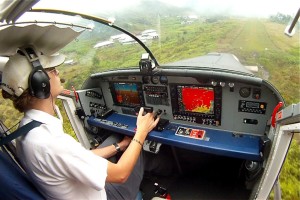 It does seem rather odd to have such a high tech setup in what is quintessentially a bush plane but it’s amazing how the Garmin G950 glass cockpit has made flying easier and safer. The Traffic Avoidance System (TAS) and GPS terrain database are fantastic additions to the older setup providing another level of situational awareness to the pilot. I’m not 100% convinced on the Primary Flight Display (PFD – screen on the left in-front of the pilot), as I still prefer the instant familiarity of the traditional “six pack” instrument setup but it’s a small price to pay for the many additional features the whole setup offers.
It does seem rather odd to have such a high tech setup in what is quintessentially a bush plane but it’s amazing how the Garmin G950 glass cockpit has made flying easier and safer. The Traffic Avoidance System (TAS) and GPS terrain database are fantastic additions to the older setup providing another level of situational awareness to the pilot. I’m not 100% convinced on the Primary Flight Display (PFD – screen on the left in-front of the pilot), as I still prefer the instant familiarity of the traditional “six pack” instrument setup but it’s a small price to pay for the many additional features the whole setup offers.2) Electric trim system – no manual cranks
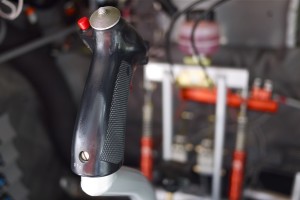 Another modern touch is the fully electrically driven trim system for all three primary flight controls. There is no manual hand crank system now. The rudder trim takes a little getting used to as there’s almost no feel or no kick back through the pedals when you’re in balance but you get used to it.
Another modern touch is the fully electrically driven trim system for all three primary flight controls. There is no manual hand crank system now. The rudder trim takes a little getting used to as there’s almost no feel or no kick back through the pedals when you’re in balance but you get used to it.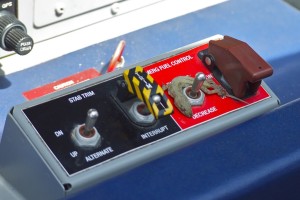 In order to save you getting into a situation where the trim is locked against a limit, Pilatus have installed a trim interrupt switch right next to the power levers which when engaged will disable all trim switches. Once engaged you then pull the circuit breaker of the problem trim motor and close the interrupt switch. The elevator trim also has a secondary motor which can be engaged to re-trim the stabiliser should the primary one have failed as it is such an important control surface.
In order to save you getting into a situation where the trim is locked against a limit, Pilatus have installed a trim interrupt switch right next to the power levers which when engaged will disable all trim switches. Once engaged you then pull the circuit breaker of the problem trim motor and close the interrupt switch. The elevator trim also has a secondary motor which can be engaged to re-trim the stabiliser should the primary one have failed as it is such an important control surface.3) Passenger seat storage
4) Trap doors
5) No flight controls on right side
6) Still hand built in Switzerland
7) Beta propeller pitch in flight
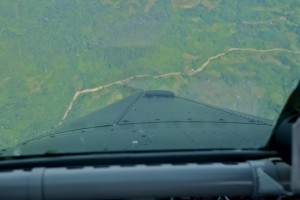 The Porter is, I believe, the only aircraft in the world approved to use beta pitch in flight. Beta pitch is a where the propeller is set at 0 degrees and produces no forward or reverse thrust. Normally this is used to slow a turbo-prop aircraft down after landing but with the Porter it can be used for rapid rates of descent. When engaged, the propeller acts like a giant air brake and thus the Porter will pretty much fall out of the sky. Handy if you need to drop into a valley through a small hole in the clouds.
The Porter is, I believe, the only aircraft in the world approved to use beta pitch in flight. Beta pitch is a where the propeller is set at 0 degrees and produces no forward or reverse thrust. Normally this is used to slow a turbo-prop aircraft down after landing but with the Porter it can be used for rapid rates of descent. When engaged, the propeller acts like a giant air brake and thus the Porter will pretty much fall out of the sky. Handy if you need to drop into a valley through a small hole in the clouds.8) Stone guards
9) Able to carry it’s own weight in load
Not many aircraft are capable of doing this. The average Porter weighs around 1400kgs and is able to carry the same again in load up to it’s maximum take-off weight of 2800kgs. Of course we need to add some fuel in there but the Porter is still capable of carrying nearly a tonne of cargo into pretty much anything you think to call an airstrip.
10) Pop-up landing lights
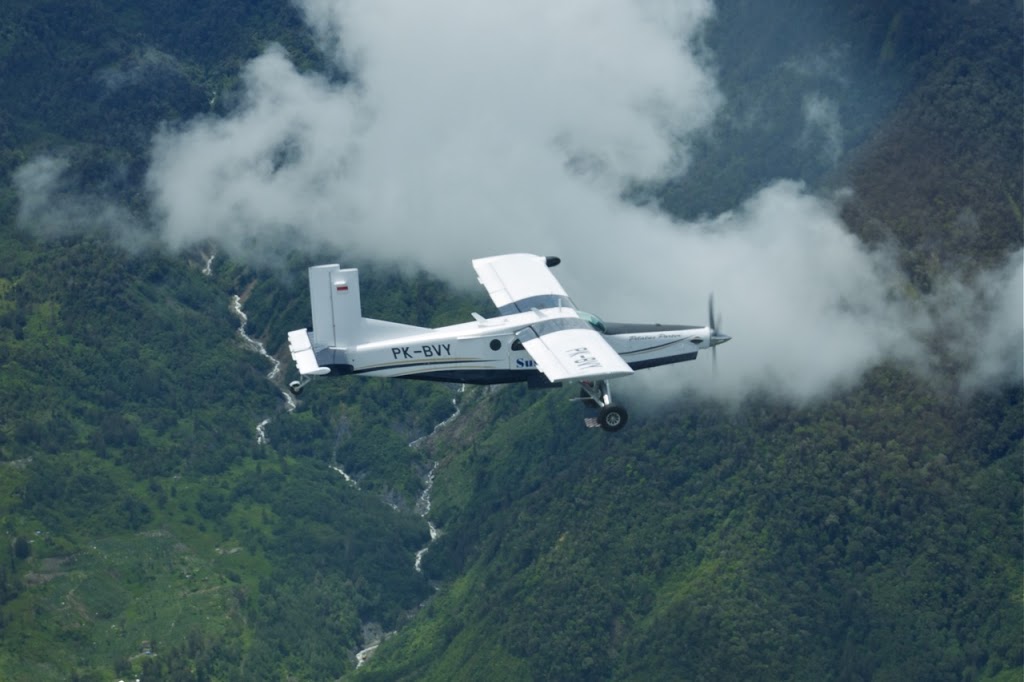

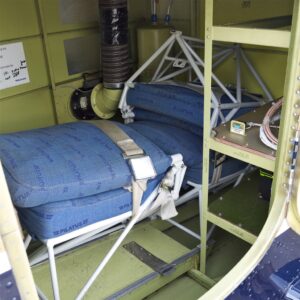
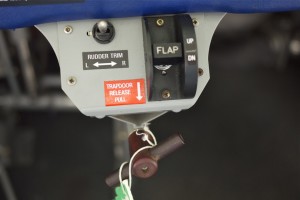



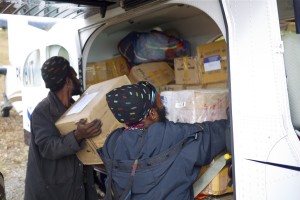

Maybe it’s just a photo but it looks like reflector of that lamp is burnt out.
Do you have to deal with icing?
I also heard from Porter pilot that if it is raining water is leaking everywhere into the cabin. Is that true? If so how Garmin 950 deals with water?
Think it’s just the angle on that photo as the light was working just fine all yesterday.
Very occasionally I’ve had a little icing but nothing significant. It is something to be aware of as when you’re up at 15,000ft it can get below zero degrees in the clouds.
The Porter does leak (like all GA aircraft) and some more than others. On the whole it leaks around the door seals so the water just ends up on the floor before running down the back and out the rear door seals. There is one in our fleet that will get a pool of water on the tray in-front of the instruments after heavy overnight rain. The G950 screens are tucked up behind the windscreen so don’t get any water on them.
Hey Matt,
Wow I didn’t know Beta was available in flight? So that was very interesting to find out. I believe that it was developed first by Cessna in turbo props, and is still used on the Caravan but only for ground use.
Just out of interest, do you use Beta pitch in your Borneo video, as you start to desend out of cloud? I have watched that video many times, and have tried to work out what is going on with the prop.
Great post again through mate. Keep it up.
Safe flying as always
Jon
Yup, that was very much a beta descent. I’ll do an article on it some day as it’s quite specific when beta pitch will engage. You can’t just pull the power lever back and get beta. And of course it varies from Porter to Porter.
Hi Matt,
Can I ask something, why you more chose a Pilatus porter than Cessna caravan,Kodiak or maybe 750XTOL? is Pilatus better in flight than other, in Papua terrain? I’m so impressed with you! I think to be a bush pilot is a work with high risk. Are you a Susiair’s pilot Matt? and I have my last question. Which is a good demand in Papua, charter for cargo or passenger?
thanks, matt
-bestregard-
I’ve only got experience of flying the Porter and Caravan but am aware of the capabilities of the other two types you’ve listed. All are flying in the mountains of Papua currently with different operators and all are suited to the flight operations out here. It all depends what the operator wants to do with the aircraft; what airstrips do they want to go to, where is the home base airfield, routes to be flown etc.
The two big advantages (in my opinion) the Porter has over the types you’ve listed is climb performance and tailwheel configuration. Being able to climb out of valleys and over steep terrain gives the Porter an edge which is unmatched and allows many routes to be flown faster as a Porter can fly a more direct track, rather than having to go around higher terrain.
The tailwheel configuration gives greater prop clearance which is helpful when operating into roughly prepared strips. I know of a nosewheel aircraft that had a propstrike recently due to this. Also, a tailwheel aircraft cannot fall onto it’s tail on steeply sloping airstrips unlike nosewheel aircraft.
I do work for them and our loads are very much a mix of pax and cargo. Normally cargo (usually rice, building materials, medications, other foods) is flown to the remote villages and people are flown back out. On subsidised routes, it’s mainly pax along with their possessions.
thanks, about your reply Matt. I hope we can meet in a someday in Papua:) I’m a sport pilot Matt, in Jakarta. and I have sportpilot’s friend in Papua also, they usually flying a Trike/microlight in a Papua. I think you’re a friendly pilot matt, not like an other foreigner pilot in indo-_-. I hope we can be a friend matt hehehee. so many question did I have about bush flying in Papua. Glad to see you matt:)
I’ve flown in a trike microlight once back in England about 15 years ago. Was a great experience! If you do ever come to Papua, please get in touch and we can meet up :o)
Nice Matt… There’s a great experience, I think fly around Papua with trike in extreme terrain,hahaaaa. where’s your home base/ operational base in papua matt? if your porter has to overhaul time, will you take your plane to Pangandaran by flight matt? because susi MRO in there
Home base Timika. Maintenance: http://indopilot.blogspot.com/2013/04/maintenance-flight.htm
Hi Matt, I’ve come across your blog several times and have only recently started to read it from start to finish after seeing you on TV. I am really enjoying it so far, but I would like to correct you on point 7. The PAC 750 XSTOL is also certified for using beta mode in flight, as I know several meat bombers (sorry, parachute drop pilots) who will routinely beat their passengers to the ground by nosing over and reaching for a fistful of beta. As someone who is not turbine rated, could you please tell us about the controls on the throttle quadrant and how you use them all on your approach and landing?
I know a few PAC750 pilots who also fly Porters and none of them mentioned it can also use beta in flight. I’ll ask one next time I see them but happy to be corrected.
I’ll see about doing a more thorough article on that and some other techie stuff in the future. For now though the lever on the right is the idle control which has three settings, high-idle, low-idle and cut-off; like piston engines if you pull it back to cut-off, the fuel to the engine is cut and it stops. The middle lever is the power and acts sort of like the throttle lever on piston engines. There’s a gate protecting reverse power so you have to lift the lever to get that. Beta pitch on the prop will engage if you bring it to idle and slow through around 100kts airspeed. The left lever is the propeller control and adjusts the speed of the prop. We tend to leave it fully forward for 2000rpm through all stages of flight.
Hello Matt, I was curious as to what the purpose of those metal rods attached to the ailerons are?
Also what are the maximum degrees of flaps the Pilatus Porter has. The photo doesn’t indicate any flaps configuration.
Thanks in advance. I’m hoping in a few years I could be a GA pilot like you here in the Philippines. Just started my flight training and I should be in a Cessna 150 by December 🙂
Hello Kevin,
Those rods you’re referring to are mass balances for the ailerons which help reduce control flutter.
The Porter’s flaps operate from 0 to 38 degrees, the later setting is used for landing. For take-offs we use 28 degrees.
Best of luck with your training and have fun!
Matt
Thanks Matt for the reply! This information will be put into good use when I build my radio control scale replica of your Pilatus Porter!
I will surely enjoy flying even though I’m still in flight school. Hopefully we will cross paths as time continues.
Don’t know if the first post went through, so here it is again:
Rigging question: When I fly our Porter and I pull the power back to idle in flight, it takes about 15 seconds before the prop goes flat and the sink rate goes way up. Is this normal or do I have a rigging problem? Also, what kind of sink rate should be had at mid weight and no flaps at idle power?
It does sound like you might have a prop rigging problem there as beta normally engages quite soon after you’ve set idle power and slowed down. Do remember to fully engage beta you first set idle power, pitch up to maintain level flight until you’ve slowed through around 100KIAS. Beta should then engage and you’ll have to start pitching down to maintain airspeed. Once it’s engaged, with flaps at take-off setting and pitched to maintain 80KIAS, I normally see around 3000fpm descent.
Hello Matt, Whats the story about the Emergency Fuel Controll “Guard”? Tame, or a paying passenger?
Just one of the many stowaways we get. Frogs, spiders, flies, mosquitoes and all other manner of flying insects forever find their way in. And they never pay for the flights!
Hello Captain Matt. My name is audric. I’m aspired to be a bush pilot to help Papuans people in Papua. But I dont’t have the funds to continue the pilot schools. I heard susiair provide scholarships pilot. Does it really exist? Thanks Captain Matt. I am Indonesian by the way hehe. God bless you.
Hello Captain Matt. My name is audric. I dreamed of being a bush pilot in Papua, but I do not have the funds for the pilot schools. I heard susiair provide scholarships to become a pilot. Does the scholarship really exist? Thanks Captain Matt. I am Indonesian by the way. God bless you:)
Hi Captain Matt. I dreamed to become a bush pilot in Papua. But I don’t have funds to study in pilot school. I heard SusiAir provide a scholarship for pilot school. Does it really exist? Thanks Captain Matt. I am Indonesian by the way
I’m afraid I left Indonesia last year but I don’t know if Susi ever setup a school or not!
Hi Matt, I fly a Porter in the mountains of Idaho. I approach at 60, flaps 38, for three point landing. I notice on round out for landing and when I come back on the power the sink rate increases pretty dramatically. Its not really an issue because of the Porter landing gear but it does give one the feeling of falling out of the sky. I wonder if I may have a Beta rigging issue or if my technique could be improved..
Joe
Hi Joe, that doesn’t sound quite right as you should be able to have a softer touchdown with the Porter and adding power certainly shouldn’t cause a rate of decent. We always had our props setup with quite an aggressive amount of beta to allow for rapid descent rates through small gaps in the cloud. Occasionally you might have one set a bit too much which when you bring the power lever back on round-out would cause it to go into beta before touchdown. You can usually hear if it’s going into beta though.. My usual landing technique (assuming a level airstrip) would be to fly the approach at 60-65 KIAS with flaps full, reducing speed and power as I go into the flare but with a tiny bit of power still set and not chopping it until the wheels touchdown. Maybe give it a go?
Hi Matt, Is it true that the Porter is to be landed always using the three-point landing technique or can it also be landed using a two-point technique (if runway length/condition is not a problem) ? Any issues about prop gnd clearance, etc. ? Many thanks!